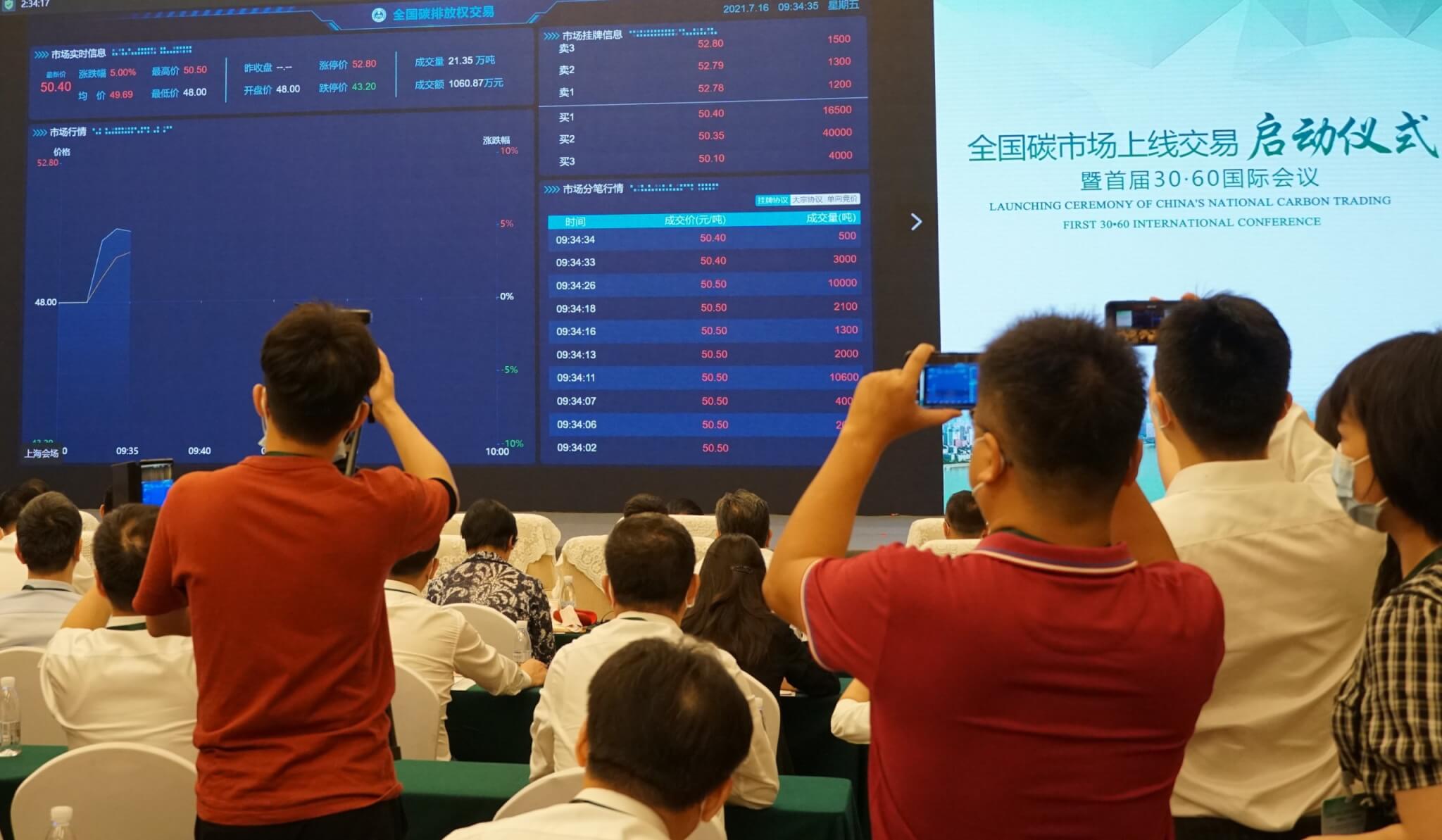
Years of groundwork came to a conclusion with the official ushering in of trading in the Chinese national emissions trading system (ETS) on 16 July 2021. The launch ceremony, which was simultaneously officiated in the cities of Beijing, Wuhan and Shanghai, saw Vice Premier HAN Zheng, in the presence of Climate Change Special Envoy XIE Zhenhua and Ministry of Ecology and Environment (MEE) Minster HUANG Runqiu, inaugurate the start of trading. On the first day of operations, the dealings comprised of more than four million tons of CO2. While the price of a single China Emission Allowances (CEA) started at CNY 48 (EUR 6.3), within a day the certificates had appreciated to CNY 51.23 (EUR 6.7) apiece.
As much as polluter charges still pale in comparison to prices more mature systems are able to command, the Chinese analogue has already become the world’s largest ETS. The 2,162 power plants at stake propagate more than 40% of China’s carbon emissions; roughly, a sixth of the world’s total. By comparison, the world’s second-biggest carbon market, the EU ETS, accounts for only half that quantity.
GIZ China was in attendance of the launch ceremony in Wuhan, where Dr. Fisher, Director of Biodiversity, Climate, and Environment, contributed to the ‘China’s Carbon Market – Outlook under the 30/60 Targets’ panel. Furthermore, MEE Party Secretary SUN Jinlong thanked the German partners and GIZ for their support in establishing China’s ETS during his welcoming remarks.

From regional pilots to national system
China’s ETS has been years in the making. Ground was first broken in 2013 when several provinces and cities initiated local trials. These exploratory endeavours helped the authorities gain experience with an ETS’ most critical aspects such as data collection, suitable allocation methods and acquainting business with the market-based instrument.
As soon as feasibility was proven in 2015, Beijing ramped up preparations for the introduction of the nationwide system. Moreover, the policy was integrated into the country’s Nationally Determined Contribution (NDC) under the Paris Agreement. With the first compliance cycle in force as of 2021 and the start of trading mid-June 2021, the preparation phase has now been completed and the ETS advances into its operational phase.
Significance in China and around the world
The achievement comes at an opportune time. President XI Jinping used last year’s UN General Assembly to announce that China would aim to peak emissions before 2030 and reach carbon neutrality three decades thereafter. With 4.5 billion tonnes of power-sector-related carbon emissions already under its auspice, the ETS has the potential to be a game changer in the country’s quest towards these objectives.
Furthermore, having the world’s currently largest absolute CO2-emitter using carbon pricing is also having a compelling normative impact. If others are inspired to adopt similar systems of their own, a global price on carbon may come closer within reach.
Notwithstanding, China’s ETS is still only in its incipient stage. For the benefits of the system to fully come to bear, policymakers in Beijing will have to iron out a set of key issues in the near future. Namely, further sectors as well as greenhouse gases need to be included. Moreover, it is critical that allocation mechanisms are strengthened and a hard upper limit is instituted.
Sino-German Cooperation
Germany has been supporting the development of the Chinese national ETS since the beginning. Financed by the German Federal Ministry for the Environment, Nature Conservation and Nuclear Safety via its International Climate Initiative, the ‘Sino-German Cooperation on Emissions Trading Systems, Carbon Market Mechanisms, and Industry-related N2O Mitigation‘ project, which is being implemented by GIZ, has been a cornerstone of the collaboration between both governments in the ambit of climate over the past decade.
During its nine-year runtime, the project has facilitated a knowledge transfer and helped build the necessary capacities for the Monitoring, Reporting and Verification (MRV) system and ETS infrastructure. Likewise, more than 5,000 individuals from Chinese agencies and businesses were trained in the ins-and-outs of the ETS.
The project, which is currently commissioned till 2022, is thus well-positioned to support the next phases of the national ETS, during which the system promises to play a pivotal role in both Chinese and global carbon mitigation efforts.
